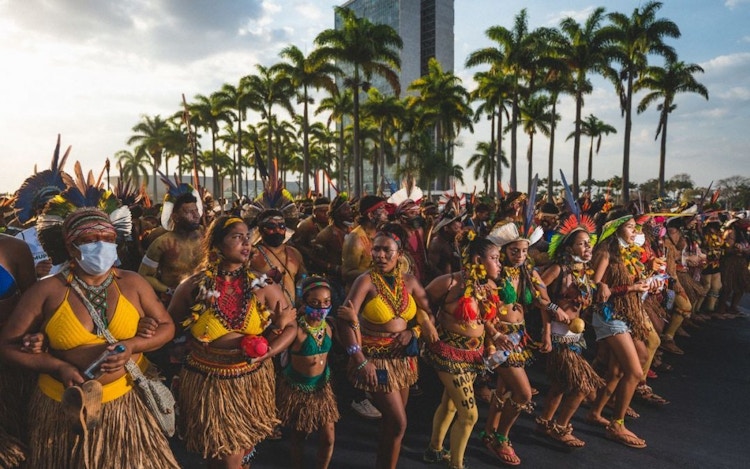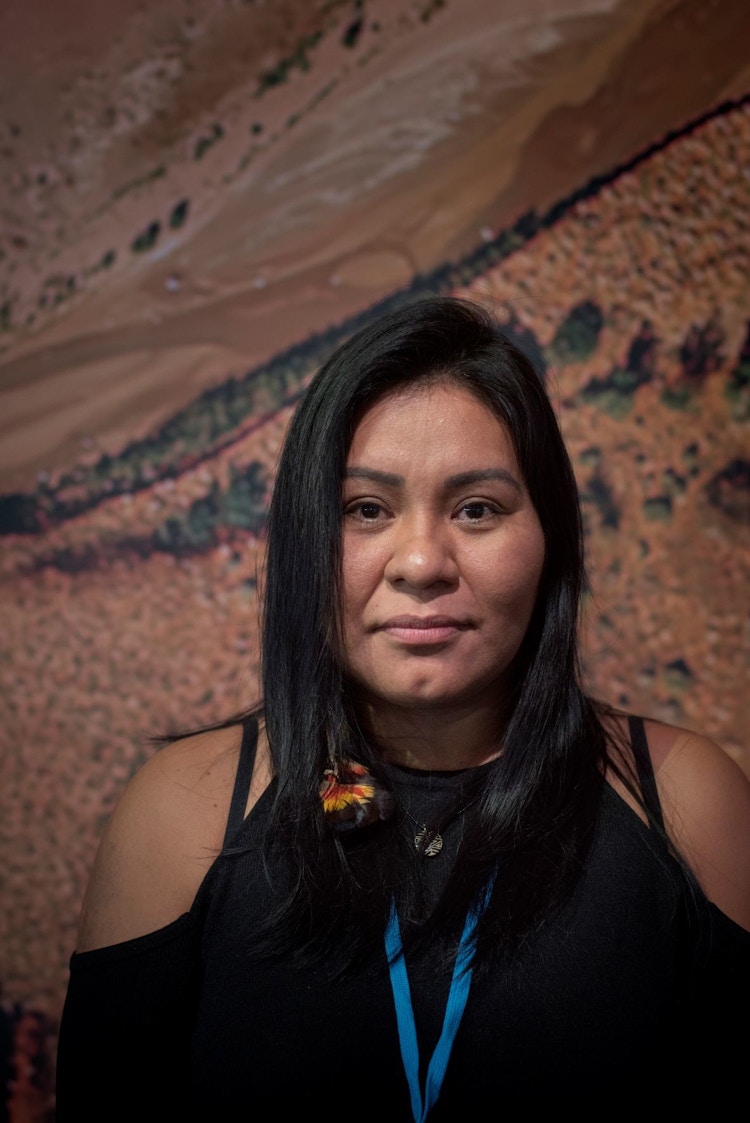The rise of Brazil’s Indigenous Women
From grassroot movements to Congress representation and a place in the global political spotlight: these indigenous women are claiming space at all levels of governance.

Indigenous women are gaining traction in their fight against environmental destruction and the trampling of indigenous rights. Photo: Articulação dos Povos Indígenas do Brasil/@apibofficial
"First we saw white women entering into politics and positions of power, then black women. Now it is Indigenous women. We advocate reform, the system changes necessary to heal the Earth,” says Telma Taurepang.
She ran for senator in Brazil's last national election. She ultimately failed to gain a seat in Congress, but managed to pick up some 14 000 votes.
“We gained this through unity, calling people, rallying, saying we had to take steps to further our political agenda within the parti-political movement. So that people can see that we have the capacity,” she says.
Telma comes from the Araçá Indigenous territory, in Roraima, were Indigenous people have historically suffered violence, discrimination and exclusion. It is now one of the most conflict filled areas of the Amazon, mostly due to a large hydroelectric plant and extensive mining activity.

"We advocate reform, the system changes necessary to heal earth," says Telma Tauerpang from Araçá Indigenous territory
Roraima is also the home of another rising, political female star: Joênia Wapichana, who ran for federal deputy in the same election. She won, becoming the first indigenous woman elected to the Brazilian Congress.
Under the current Brazilian government, described as the most conservative the country has seen in decades, deforestation has skyrocketed and laws to protect the environment and Indigenous rights are systematically being dismantled. Under this regime, Wapichana is one of the very few Indigenous representatives at the federal level.
Roraima is not the only region fostering female leaders. The women’s movement has grown exponentially across Brazil in the past few years.
A women’s march in 2019 gathered one hundred thousand women protestors in the capital Brasilia, condemning the dismantling of environmental and social rights and demanding freedom from violence.
Women bear the brunt of violence
As much as 25% of Indigenous lands are illegally mined and toxins from the mining process cause cancer and malnutrition in the local populations. Women bear the brunt of this suffering, caring for the sick and experiencing sexual violence from the miners.
ANMIGA, the national grassroot movement of Indigenous women organizes so-called safe spaces for women to channel the wisdom and knowledge from female ancestors and fight for environmental and social justice. Women now populate boards and what has traditionally been seen as male roles, in finance and politics. Rainforest Foundation Norway has supported the Indigenous women’s movement in Brazil for the past years, through programmes with Indigenous partner organisations such as APIB, RCA, ATIX and FOIRN.
Amairé Kaiaby Suya, a women’s field coordinator from Xingu, remembers the struggle to take the space in a male dominated culture.
“The problem from the beginning was gaining acceptance by men that women also had a voice and decision power in the debates. Men always told the women that they didn't have to participate because the men were in charge of the Indigenous movement and of the struggle," she says. Amairé and her fellow female campaigners began to hold their own meetings, with their own agendas, from village gatherings to regional meetings. Today, the Indigenous organization of Xingu, ATIX, has its own female branch, ATIX Mulher, which became instrumental in the contagion management and health care during the worst of the COVID pandemic.

Maial Panhpunu Payakan Kayapo is breaking barriers both within the indigenous community and the sphere of governance.
Blasting through barriers
To Maial Panhpunu Payakan Kayapo being a leader runs in her veins. She is the daughter of one of Brazil’s most renowned Indigenous leaders, Paulinho Payakan, who lost his life to COVID in 2020. As a child, Maial and her sister used to follow their dad to meetings, who would often hand the microphone over to his daughters, in order to build their confidence of public speaking.
“My sister is the first female Kayapo leader in our territory. We are breaking all the barriers as Indigenous women, both within our own people and outside in the cities,” Maial says, pointing to the fact that she herself is the first Kayapo woman to hold a law degree.
She believes that women provide an alternative -- and highly effective -- method of fighting for indigenous rights and protecting the forest.
“Many times we have seen men going out of the villages and negotiating on behalf of the territories in the wrong way. You don’t see women negotiating against the interest of the community. We are fighting for the forest, for our children, for the collective."
When her father took her out of the villages to the city as a young girl, he was told to leave her behind in the territory, as the cities were considered too dangerous.
“My father would tell them: One day you are going to need her. She will keep this fight. That is exactly what happened. Me and my sister went to the city, we studied and went back to help our people. That is what I meant by breaking all the barriers,” Maial says.
Dangerous activism

Medical student Juma Xipaya has been targeted in several assassination attempts for her political activism. The police have failed to investigate any of them.
For Brazilian women, political activism is not without its dangers. The more visible and powerful the women’s movements get, the more they are subjected to threats and violence.
In March 2021, a group of female leaders of the Munduruku people of the Amazon’s upper Tapajo valley, were forced to go into hiding after illegal miners reportedly attacked and burned their offices. Several women who had participated in demonstrations against mining in their territory received death threats.
Threats that are very real. One third of all murdered environmental activists worldwide in 2021 were Indigenous people, according to Global Witness’ latest report.
To medical student Juma Xipaya, living with constant death threats has become a way of life. She grew up in the Xipaya territory, in the lower Xingu river, an area heavily impacted by highway construction and the Belo Monte super-dam. After exposing corruption and incompetence in its management, her life has become restricted. These days she rarely goes outside alone, her physical movements limited to the short distance between the university and her home.
For longer periods of time, she has been confined to the home, with gunmen loitering outside. She has escaped several assassination attempts, by poisoning and a dramatic car crash.
Neither incidence has been investigated by the police.
Juma no longer lives together with her two children. It is not safe. “When they threatened to kidnap my son when he was only a year and a half, I felt pain I’d never felt before in my life. It was my first feeling of fear,” she says.
Yet, she has not given up the fight: “I will not curb myself to threats, machismo, corruption and deliberate attempts to silencing Indigenous voices.”
She has considered moving away but saw no freedom in moving from the forest. “I don’t want my children to experience the same as I have. I want them to be able to be Indigenous, keep their culture and live in their territories.”
In 2020, Juma fulfilled a long standing dream and founded her own medical centre, the Juma Institute. Her aim is to combine traditional and western medicine and create a place to help young people in her community develop skills, bring generations together and preserve traditional medical knowledge. Her fight and perseverance is beginning to garner international recognition: at the COP26 meeting in Glasgow, for example, she gained a devoted follower in Leonardo DiCaprio, who promised to support the Juma Institute.
Funding must reach women
Preserving traditional knowledge of the rainforest has been one of the core causes for the Indigenous Women’s movement. A goal that aligns with the increased acknowledgement from the international scientific community on validating Indigenous knowledge, both in medicine as well as in forest management.
Indigenous areas generally have a lower deforestation rate and a higher density of biodiversity compared to all other types of land tenure, public or private. Yet Indigenous communities have so far received less than one percent of global climate and nature funds. This might change. During COP26 in Glasgow, world leaders and international philanthropists pledged 1.7 billion dollars to forest management by Indigenous people.
“The pledge was a great recognition of the vital role Indigenous communities play in preserving the rainforest. However, for this to succeed, it is important to remember that Indigenous communities are not homogenous groups. Women have a natural and crucial role in negotiating how funding and management plans should be implemented in their communities,” says Anna Bjørndal, Head of International Programme at Rainforest Foundation Norway.
Connecting with Mother Earth
Forest protection is at the core of the Indigenous Women’s movement in Brazil. The latest campaign by the national Indigenous Women’s organization ANMIGA, has aptly been named Reforesting The Mind, calling for a reconnection with Earth.
Indigenous cosmology is rooted in an interaction with nature and all living things. It is this world view that informs the environmental struggle. According to the renowned Brazilian indigenous activist Sonia Guajajara, women are well placed to spearhead this fight:
“Women are Mother Earth. You take care of your mother, you protect her, because she has given your life. The Earth is our own body and spirit," she says.
